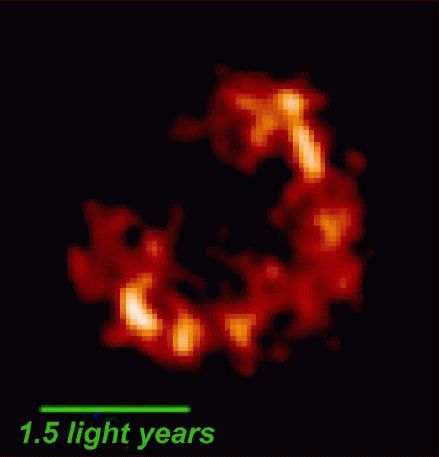
|
Credit & Copyright: A. Pedlar and
T. Muxlow
(Jodrell Bank,Univ. Manchester),
K. A. Wills (Univ. Sheffield),
et al.
Explanation:
This false-color radio wavelength picture
of an expanding stellar debris cloud
is the product of one of the
largest radio astronomy experiments ever.
Combining the output of 20 radio telescopes
scattered around planet Earth,
astronomers have produced this amazingly detailed
image of a supernova remnant just over 1.5 light-years across in
M82,
an intense star forming galaxy 12 million light-years away.
The radio astronomy
technique for creating the earth-sized
array of telescopes is known as
VLBI (very long baseline
interferometry).
The individual telescopes of the array are too far apart for
all their signals to be combined in "real time", so their output
was recorded on magnetic tapes which were
brought to a single location and
correlated.
This technique has produced the highest resolution
astronomical observations currently possible and
allows the exploration of such distant,
violent galactic environments
in unprecedented detail.
|
January February March April May June July August September October November December |
| ||||||||||||||||||||||||||||||||||||||||||||||||
NASA Web Site Statements, Warnings, and Disclaimers
NASA Official: Jay Norris. Specific rights apply.
A service of: LHEA at NASA / GSFC
& Michigan Tech. U.
Based on Astronomy Picture
Of the Day
Publications with keywords: VLBI - radio astronomy - supernova remnant - supernova - M 82
Publications with words: VLBI - radio astronomy - supernova remnant - supernova - M 82
See also:
- 38 Hours in the M81 Group
- Supernova Remnant Cassiopeia A
- APOD: 2025 January 8 Á Supernova Remnants Big and Small
- APOD: 2024 September 18 Á The Mermaid Nebula Supernova Remnant
- APOD: 2024 April 16 Á Filaments of the Vela Supernova Remnant
- APOD: 2024 April 15 Á The Cigar Galaxy from Hubble and Webb
- APOD: 2024 April 3 Á Unusual Nebula Pa 30
